With record setting drought hitting much of the west, there has never been a better time to install a water efficient toilet. In this post, we give our top picks, plus a rundown on MaP ratings and WaterSense certification.
Table of Contents
It’s not glamorous, but it’s time to talk toilets. If you’re still paying visits to a very old, inefficient toilet, you’re likely flushing 7 gallons of water away every flush. Compare that to less than 1.5 gallons for most modern toilets and it’s clear to see why an upgrade to the throne is needed, especially in areas facing annual water shortages.
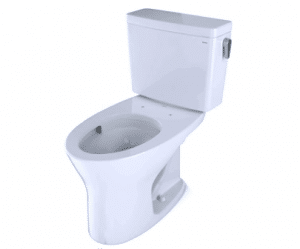
Our top pick for a water saving toilet
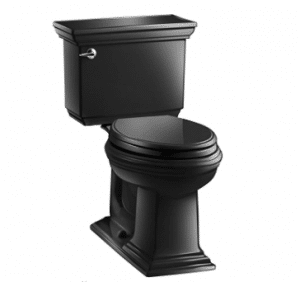
Runner up
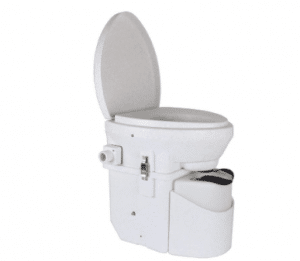
Best composting toilet
In 1994, legislation was brought in by the US Environmental Protection Agency requiring all toilets to use a maximum of 1.6 gallons of water for each flush. Because this legislation was enacted quite quickly, many existing toilets were rapidly and badly redesigned, resulting in poor flushing power and a lot of complaints.
Water efficient toilets have improved
Thankfully, 1994 was nearly 30 years ago and while many toilets now use 1.28 gallons per flush or less, these water-efficient toilets are extremely good at what they do. So much so, that any toilet sporting the WaterSense label has both low flush volume and performance that matches or exceeds that of toilets with far higher flush volumes.
Look for MaP ratings and WaterSense certification
Want to be sure your chosen toilet is up to the task? Maximum Performance (MaP) ratings enable comparison of individual toilet models. A good performer has a 350+ grams MaP rating, while standout performers have a 600+ grams MaP rating.
WaterSense is a certification endorsed by the EPA that demonstrates rigorous water efficiency. The EPA estimates that families with WaterSense certified toilets can save as much as 13,000 gallons of water every year! WaterSense toilets often come with rebates and vouchers to lower their cost, and the program requires that toilets meet rigorous standards. So, if you’re looking for a water-efficient, sustainable toilet, WaterSense is where it’s at. But are there other considerations too? You bet.
For one, it can be tricky to recycle a toilet. It shouldn’t be, given that the component parts – porcelain, metal, some plastic on some models – are all easily recycled. The problem is infrastructure, with few recycling facilities set up to process something as large as a toilet. So, where does an old toilet go? Landfill.
There are other, better, ways (see below). But in truth, if your current toilet is fairly water-efficient it may be best to stick with what you’ve got. After all, there’s water involved in the creation of a whole new product, and fossil fuels involved in shipping these heavy items. If you have the option, you could look into installing a water-saving device in your current toilet. FlushSaver make a perennially popular range of such devices designed to work with a variety of toilet systems (view on Amazon).
Why to avoid pressure assist toilets
Personally, I would also avoid investing in a pressure assist toilet. These much more expensive models use air pressure to force a more powerful flush while still using less water. It sounds good and does save water and space (a good fit if you have a tiny space for a tank), but the toilet has more moving parts. This means more can go wrong, with pressure assist toilets more likely to need repair or replacement. Not exactly sustainable, so I’d avoid these unless space is your main issue.
If your current toilet is outright dysfunctional, inefficient, and has to go, however, get a WaterSense water-saving toilet.
The best water-saving toilets: our top picks
After hours of research, these are our top choices for water-efficient toilets that are truly good quality and save water.
Want to know how often you should flush your toilet? Here’s some potty talk.

Not only are Toto toilets water-saving, the company also collaborates with Crossville to recycle porcelain toilets. And most of their toilets are made in the USA. Bonus points for sustainability! This dual-flush toilet is available with a 1.28 and 0.8 full and half flush capacity as well as smaller and larger (1 gallon and 1.6 gallon) flush options with a 0.8 gallon half flush. Toto toilets get excellent MaP ratings and are affordable, stylish, and available nationwide with or without a bidet seat.

Kohler
Highlights: Made in America by an award-winning eco-friendly company engaged in a Net Zero effort, porcelain recycling, and social impact work.
Not only is this toilet made in America, it’s also quite beautiful. So, if you’re looking for a more stately porcelain throne, check out the Kohler Memoirs Stately Toilet. It has a 1.28 gallon flush and WaterSense approval, as well as a comfortable elongated bowl, and it’s made by an award-winning company that’s been around since the 1800s.
In 2017, Kohler won the U.S. Green Building Council (USGBC) Ray Anderson Radical Industrialism Award for its efforts to reduce the environmental impact of its operations, create more sustainable products, and for its socially responsible practices. Kohler announced its Net Zero 2035 program in 2008, with a commitment to reducing waste to landfill and carbon emissions. Since then, it has reduced its environmental footprint per unit of revenue by more than 30 percent.
Kohler partners with non-profits addressing water sustainability issues, including the Alliance for Water Efficiency, the “Change the Course” Colorado River restoration campaign, Ceres Connect the Drops, and Lava Mae. The company has also partnered with WaterSense since this program was founded and has earned 10 consecutive awards for its leadership in producing and promoting water-efficient plumbing fixtures, faucets and showerheads.
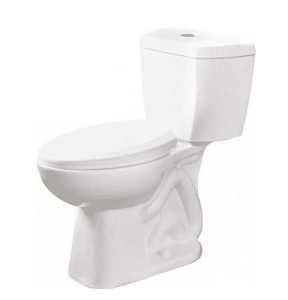
Niagara
Highlights: Super low flow toilet that is very affordable and uses just 0.8 gallons per flush.
Very affordable at around just $139 from Home Depot, the Niagara Stealth claims to be the world’s only 0.8 gallon single flush toilet. It is extremely quiet, quick to install, and is gravity fed, so no pressure assist, just great design. Ultra-high efficiency, Niagara Stealth also has a top MaP rating and is WaterSense approved.
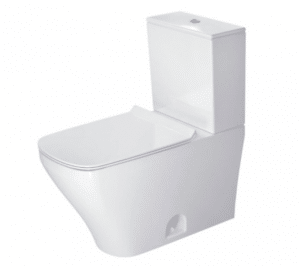
Duravit
Highlights: Environmentally committed company with a wide range of MaP rated and WaterSense certified toilets.
Duravit is a company doing its best to save resources during manufacturing. This includes heat recovery and water treatment and recovery, along with careful use of natural resources. Duravit carries ISO 14001, certifying its commitment to sound environmental practices in manufacturing. And, unsurprisingly, Duravit toilets are WaterSense certified and have a MaP rating of over 1000 grams for most, if not all, models.
While I’d recommend the Duravit dual-flush models, the company also makes SensoWash toilets that offer bidet function. While these are great for saving on toilet paper, they are pressure assist toilets, so not my top choice. If space is a concern, however, and cost isn’t, these could be the perfect toilet for you! Check out the SensoWash i Lite EL (view on ) and the SensoWash i Plus EL (view on ), both of which are 1000+ grams MaP rated models.
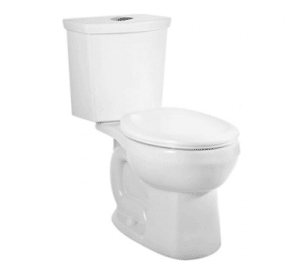
American Standard make a vast array of MaP rated 1000+ toilets including many dual-flush options. The company has been in business for more than 140 years and still makes many of its products in the US, with an effort to make water-saving faucets, showers, and ultra-high-efficiency toilets. This dual-flush toilet has a full 1.28 gallon flush and a 0.92 gallon half flush, with a fully glazed trapway to help prevent clogs and keep things running nice and smoothly.
Bonus option – consider a composting toilet!
Beloved by some and hated by others, composting toilets are arguably the most eco-friendly and sustainable options around.

Nature’s Head Composting Toilet
Highlights: A well-loved composting toilet that looks a lot like a regular toilet!
The Nature’s Head Composting Toilet has a rugged design, having been created for use on boats and is made in part with stainless steel. Most repairs can be made using just a regular screwdriver, and while it looks like a regular toilet it is water-free and perfect for off-grid living, tiny homes, campers, and RVs.
Sure, there’s more work involved in maintaining a composting toilet, with the urine jug needing to be dealt with every few days and the solid waste every couple of weeks, depending on use. But this design seems to be a favorite with many, with a smart sealed design and a fan that helps keep smells to a minimum. It’s pricey, but you’ll save on your water utility bill, so it could pay for itself in a few years.
Can you recycle a toilet?
Most toilets are made with porcelain, which is basically kiln-baked kaolin clay or other clays glazed with paint and held together with metal screws and rivets. There may also be some plastic components, including seat covers, and synthetic rubber, plastic, and metal components inside the cistern.
While it’s unlikely to be anybody’s idea of a good time, taking apart an old toilet is fairly straightforward. The different materials can be separated with relative ease because they haven’t been chemically altered to hold together.
So, what can you do with an old toilet? Well, first you are going to want to take it apart. That means giving a good clean, so it’s less unpleasant to work with; disconnecting the water supply, and then flushing several times until the bowl and tank are drained. Next, unbolt it from the floor and get some help to move it somewhere you can work on it. Give it another, more thorough, clean if necessary. At this stage, if the toilet is still usable, consider donating it to Habitat for Humanity, ReStore, or other local secondhand goods outlet or charity (contact them first). You might also want to list it on local marketplaces or ask any friends, family, neighbors, or colleagues if they know anyone in the market for a free toilet.
If the toilet is to be scrapped, remove the plastic and metal pieces first. These should be recyclable through your local facilities – give them a call to ask before heading over. As for the porcelain, there are methods to crush this and turn it back into usable material. For instance, porcelain can be used for construction projects and landscaping. Rock and aggregate have long been favored because they are cheap and perhaps easier to use, but some governments and companies are using crushed, reclaimed porcelain instead.
In New York, the city’s Department of Environmental Protection (DEP) has been quietly using recycled porcelain from plumbing as underfill on school fields. This porous underfill allows for huge amounts of stormwater runoff to be diverted and retained, helping to prevent rivers from flooding. Colorado also uses recycled porcelain for construction projects. It’s a good idea, then, to check in with local government and/or recycling operators to figure out your best option.
Alternatively, you might want to contact tile companies to see if they can also recycle porcelain toilets. Crossville Inc. has a wildly successful Tile Take-Back Program, with more than 126 million pounds of tile diverted from landfill since the program began in 2009. Crossville’s own tiles are now made in part with recycled porcelain, and they are a net consumer of tile waste – meaning they recycle more tile than they produce.
In 2011, Crossville partnered with sanitary wares manufacturer TOTO USA®, allowing the company to recycle pre-consumer porcelain toilets and other cast-off products that would normally be discarded. In 2018 alone, that likely amounted to more than 4 million pounds of porcelain toilets recycled through TOTO and Crossville.
Other, smaller, companies have similar programs, so ask around next time you remodel a kitchen, bathroom, mudroom, or other tiled area.
Want to upcycle or recycle your toilet at home?
Looking for a quirkier option? Consider upcycling your old loo into a feature planter or bird bath in the garden. Just put it in place and fill the bowl and tank with soil. You might want to add a few small rocks or pebbles at the bottom of the bowl to help with drainage. Then get planting!
And finally, if you’re feeling in the mood to smash something to smithereens, get your protective goggles, gloves, and Kevlar suit on and get busy with a sledgehammer. Bashed to bits, your old porcelain toilet can quickly become recycled fill for your own garden projects. Be aware that the shards are liable to be very sharp though and can easily cut you and any inquisitive children, dogs, cats, and wildlife, so you’re going to want to bury the fill deep to help aerate your soil.